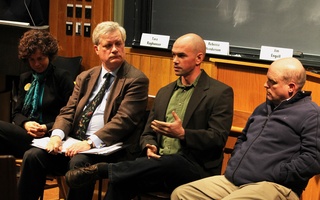But what Navy Captain Ronald H. Henderson ’76 would say is the defining moment of his professional life is what he is doing right now—commanding the USS Juneau, an amphibious warship with a crew of 1,000.
Currently, Henderson is guiding the ship in the Coral Sea.
If Henderson proves himself capable of handling a large ship in this mission, says Vice Admiral Timothy J. Keating, Henderson’s former boss, he may find himself commanding an aircraft carrier, one of the most prestigious and trying jobs in the Navy.
During his current mission, there is absolutely no room for error, for only one or two captains are chosen each year to take the helm of a carrier.
“One mistake and you’ve reached the end of your career,” says Henderson’s former Quincy House roommate Douglas M. Schmidt ’76.
Henderson seems the ideal man for the job. He has proven his courage in the skies over Iraq and his leadership ability as commander of a squadron of FA-18 fighter jets that earned the “best in the Navy” distinction.
Born and raised in Strafford, Pa., Henderson grew up with dreams of flying warplanes—a goal that would stay with him.
Although the anthropology concentrator did not come to Harvard knowing that the military was in his future, the dream was always on his mind. According to Schmidt, Henderson would play war strategy games like “Battleship” to relax.
The 1970s, in the aftermath of the 1969 University Hall takeover, was not military friendly. But Henderson still felt drawn to service and decided to talk to a recruiter about becoming an intelligence officer.
“My friends thought I was crazy,” Henderson wrote in an e-mail from the USS Juneau.
When the recruiter seemed more interested in steering Henderson toward flight school than intelligence, Henderson was sold.
“He rekindled dreams I have had since childhood to fly high performance jets from the decks of an aircraft carrier,” he recalls.
Henderson excelled at flight school and soon was chosen to be commanding officer of Strike Fighter Squadron 146, his first command. VFA-146, as the squadron was called in military jargon, went on to win the Estocin Award as the top FA18 squadron in the Navy. The success of VFA-146 made Henderson consider a career in the Navy more seriously.
“This positive experience in command helped encourage me to stay in the Navy and seek even greater responsibility in Major Command,” Henderson writes.
During that time, Henderson’s alma mater became subject of much good-natured ribbing from the other FA18 pilots. In the air, fighter pilots identify themselves by a short “call sign.” Henderson’s call sign became “Harv”—short for Harvard. The name stuck.
Read more in News
Lost in the Blur of the Changing SquareRecommended Articles
-
Loker Commons Seeking Artists, PerformersA pair of new initiatives are aiming to establish Loker Commons as more than just an eatery. Memorial Hall/Lowell Hall
-
Commons Events Lend AtmosphereE ven as our Crimson Cash dwindles away, Loker Commons is becoming a cozy and comfortable place to hang out.
-
UMass Sweeps Softball, Snaps Win StreakHere are the facts: the UMass softball team had a 0.96 ERA, the fifth best in the nation, going into
-
Salient Staff Elects Gay EditorHarvard's leading conservative publication, The Harvard Salient, is now under new leadership. Last Monday, the Board of Directors of The
-
 Forum Debates University Divestment
Forum Debates University Divestment -
 Men's Soccer Eyes Win in Final Non-Conference Contest
Men's Soccer Eyes Win in Final Non-Conference Contest













